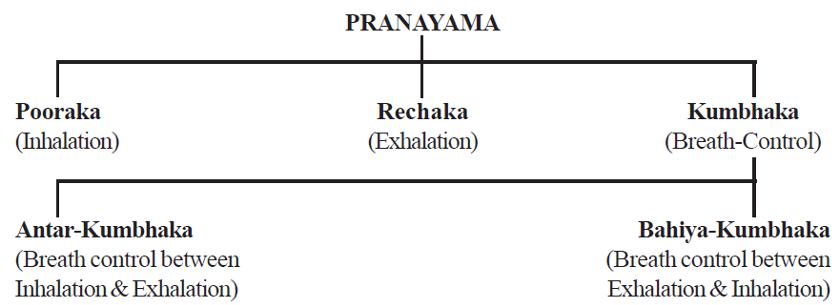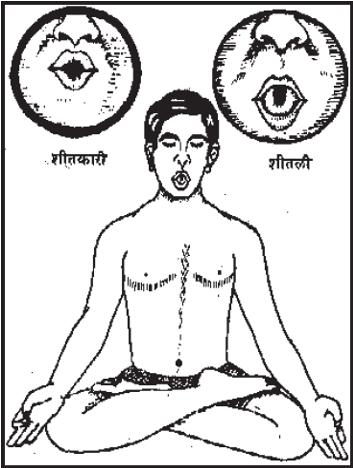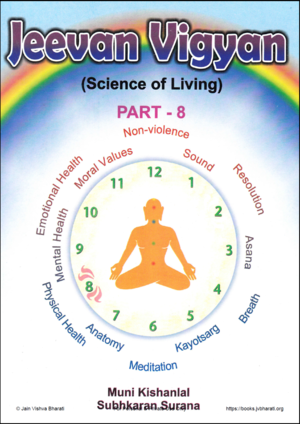PRANAYAMA
The word Pranayama consists of two Sanskrit words: prana and ayama. Prana (the breath)is the life-force. We are alive only because of prana. If an animate object is stated to be alive, it is proved only by its breathing. That element of air which we inhale into our lungs is called (the breathe)—the shvasa. When the same air is exhaled out of lungs, it is called the prashvasa. When we refer to shvasa and prashvasa as actions, it is meant that air is being inhaled (taken into the lungs) and exhaled (ejected out of the lungs). This is also known as respiratory cycle. The time-span of a respiratory cycle differs from one living being to another.
The second world ayama means expansion, i.e. regulated and planned action. Both these words together convey a meaning of higher level than just breathing in or out in an ordinary sense.
Prana flows into various veins and cells of our body through the breath. Blood acts as a medium through which this flow is carried out. Pranayama is, therefore, a planned and regulated exercise of breathing for the purpose of expansion in respiratory cycles in a time span.
To understand the concept of Pranayama, we may take the example of electricity. Electricity flows in a wire. It expresses its presence when an electric bulb lights up. It must be clearly understood here that the electricity that flows in and electric wire is different from the light given by an electric bulb. Electricity is a kind of power by itself. We have said earlier that the prana is the life-force. The same prana, like electricity, is manifested in human living beings as life.
There are three phases of Pranayama. Inhaling action is called pooraka and exhaling action is called precharge or rechana. Once inhalation (pooraka) is complete, there is a short interval before the next exhalation. This interval of retaining the breath inside the lungs is known as the Kumbhaka. While the breath is still inside the lungs, it is called antar-kumbhaka. Another similar event takes place when exhalation is complete and inhalation is yet to begin. This brief interval between rechaka and pooraka is known as bahiya kumbhaka.
Now we can say that there are three phases of the Pranayama as clarified by the following out-line:

We must understand that breathing is regulated automatically by the control centres of respiratory system. Changes in breathing cycle occur in human beings under different circumstances. Excitement, pain, variation in outside temperature, change in the percentage of carbon dioxide in the air and growing age are some of the factors that bring about changes in the normal breathing cycle. Like heart beat breathing per minute gradually decreases from infancy to youth. It once again increases in the old age. A new born baby breathes 40 to 50 times per minute. Whereas a man of18 years breathes 14 to 20 times per minute.
The breathing action is carried on the each moment of our lives. It gets automatically cleaned up when one coughs or sneezes. A long sigh is another way of inhalation. Instantly the same air, highly compressed, goes out by way of exhalation. This causes an extensive flow of air in the lungs. Through the medium of Pranayama, the breathing can be concentrated from a natural to an optional activity as per the individual's need.
PERFORMANCE (Practical side) OF PRANAYAMA
We have gained sufficient knowledge regarding the meaning, different aspects related to breathing and the automatic regulation of breathing. We have also been practicing Pranayama from the previous classes. These are:
- Anulom-Vilom Pranayama
- Bhastrika Pranayama
- Chandrabhedi Pranayama
- Suryabhedi Pranayama
In this class, we will study and practice three new kinds of Pranayama. These are:
- Sheetali Pranayama
- Sheetkari Pranayama
- Kapalbhati Pranayama.
Before we learn these, it would be better to revise the precautions which we must observe while carrying out the exercises of Pranayama.
SPECIAL PRECAUTIONS:
Following precautions are to be observed while doing Pranayama:
- Pranayama is to be done after performing asanas.
- Padmasana, Sukhasana and Vajrasana are ideal positions for doing Pranayama.
- Stomach and bladder should be empty while performing Pranayama exercises.
- The atmosphere must be calm and clean without any disturbance where Pranayama is being performed.
- There should be an interval of at least one hour after meals before Pranayama is done.
- Do not allow body organ to come under stress or tension while doing Pranayama. The body must be relaxed, and face should reflect calmness.
- The practice of the Kumbhaka may be increased gradually. Generally, remain in the posture of Antar-Kumbhaka and Bahiya Kumbhaka from 5 to 10 seconds. Breathing should be absolutely natural. Don't exert any force.
- Those who practice Pranayama must never indulge in smoking or take intoxicating drugs.
- Sahaj Pranayama can be done at any hour.
Observing the above precautions, we will now discuss three new exercises specified for this class, their procedure and related aspects turn-by-turn.

(a) SHEETALIPRANAYAMA: PROCEDURE
Following are the stages specified for carrying out the Sheetali Pranayama:
- Assume the posture of Sukhasana.
- The chin should be 4 inches above the throat-well. Neck and spine should be in a straight line.
- Roll the tongue like a tube and bring it out of lips.
- Inhale through the tube shaped tongue. After full inhalation, close the lips.
- Exhale slowly through the nose.
- Repeat inhalation as specified in stage 4 and exhale as specified in stage 5.
- Repeat this exercise 5 times.
ADVANTAGES: This exercise helps the heat and dryness of body to disappear. Gradually we began to feel cool. Once this stage is reached Pranayama should be stopped.
(b) SHEETKARIPRANAYAMA: PROCEDURE
Following are the stages for carrying out this exercise:
- Assume the position of Padmasana or Sukhasana.
- Bring out the tongue in between teeth up to lips.
- Now spread the lips wide and inhale over the tongue with a Sheetkar sound (loud sucking sound).
- Retain the breath for about 4-5 second.
- Retract the tongue, close the mouth and exhale slowly through the nose.
- Repeat the stages 2, 3, 4 and 5 in the same sequence.
ADVANTAGES: This exercise reduces the intensity of hunger, thirst, obsession, drowsiness and laziness. It neutralizes the ill-effects of the excess of bile. The life element is re-vitalized by Pooraka (inhalation). The entire body becomes strong and full of vitality.
(c) KAPALBHATIPRANAYAMA: PROCEDURE
Following are the stages for carrying out this kind of Pranayama:
- Assume he position of Padmasana or Sukhasana.
- Head, neck and spine should be in a straight line.
- Inhale deeply.
- Without stopping for the Kumbhaka, exhale in short quantities till the lungs are totally empty. While exhaling, retract stomach muscles; lift the diaphragm upwards.
- Without stopping for Kumbhaka, inhale slowly.
- Exhale as specified in stage 4. Repeat this exercise 10 times.
ADVANTAGES: This exercise cures phlegm and cough. It imparts a glow to the face and the visage.
EXERCISE
- What is the meaning of Pranayama?
- What are the positions in which the exercises of Pranayama are to be carried out?
- What are the precautions which must be observed before commencing the Pranayama?
- Describe the procedure for Sheetali Pranayama.
- Describe the advantages of carrying out the exercises of Sheetali, Sheetkari and Kapalbhati Pranayama.
